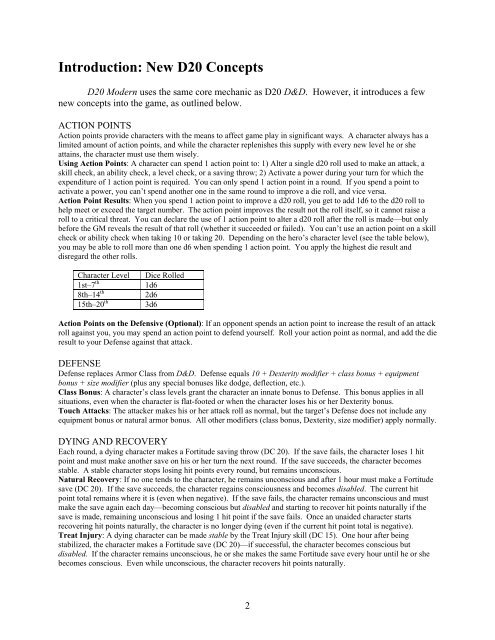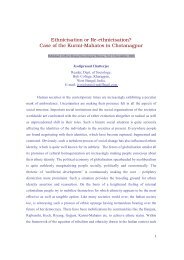D20 Superhero! Handbook
D20 Superhero! Handbook
D20 Superhero! Handbook
Create successful ePaper yourself
Turn your PDF publications into a flip-book with our unique Google optimized e-Paper software.
Introduction: New <strong>D20</strong> Concepts<br />
<strong>D20</strong> Modern uses the same core mechanic as <strong>D20</strong> D&D. However, it introduces a few<br />
new concepts into the game, as outlined below.<br />
ACTION POINTS<br />
Action points provide characters with the means to affect game play in significant ways. A character always has a<br />
limited amount of action points, and while the character replenishes this supply with every new level he or she<br />
attains, the character must use them wisely.<br />
Using Action Points: A character can spend 1 action point to: 1) Alter a single d20 roll used to make an attack, a<br />
skill check, an ability check, a level check, or a saving throw; 2) Activate a power during your turn for which the<br />
expenditure of 1 action point is required. You can only spend 1 action point in a round. If you spend a point to<br />
activate a power, you can’t spend another one in the same round to improve a die roll, and vice versa.<br />
Action Point Results: When you spend 1 action point to improve a d20 roll, you get to add 1d6 to the d20 roll to<br />
help meet or exceed the target number. The action point improves the result not the roll itself, so it cannot raise a<br />
roll to a critical threat. You can declare the use of 1 action point to alter a d20 roll after the roll is made—but only<br />
before the GM reveals the result of that roll (whether it succeeded or failed). You can’t use an action point on a skill<br />
check or ability check when taking 10 or taking 20. Depending on the hero’s character level (see the table below),<br />
you may be able to roll more than one d6 when spending 1 action point. You apply the highest die result and<br />
disregard the other rolls.<br />
Character Level Dice Rolled<br />
1st–7 th<br />
1d6<br />
8th–14 th<br />
2d6<br />
15th–20 th<br />
3d6<br />
Action Points on the Defensive (Optional): If an opponent spends an action point to increase the result of an attack<br />
roll against you, you may spend an action point to defend yourself. Roll your action point as normal, and add the die<br />
result to your Defense against that attack.<br />
DEFENSE<br />
Defense replaces Armor Class from D&D. Defense equals 10 + Dexterity modifier + class bonus + equipment<br />
bonus + size modifier (plus any special bonuses like dodge, deflection, etc.).<br />
Class Bonus: A character’s class levels grant the character an innate bonus to Defense. This bonus applies in all<br />
situations, even when the character is flat-footed or when the character loses his or her Dexterity bonus.<br />
Touch Attacks: The attacker makes his or her attack roll as normal, but the target’s Defense does not include any<br />
equipment bonus or natural armor bonus. All other modifiers (class bonus, Dexterity, size modifier) apply normally.<br />
DYING AND RECOVERY<br />
Each round, a dying character makes a Fortitude saving throw (DC 20). If the save fails, the character loses 1 hit<br />
point and must make another save on his or her turn the next round. If the save succeeds, the character becomes<br />
stable. A stable character stops losing hit points every round, but remains unconscious.<br />
Natural Recovery: If no one tends to the character, he remains unconscious and after 1 hour must make a Fortitude<br />
save (DC 20). If the save succeeds, the character regains consciousness and becomes disabled. The current hit<br />
point total remains where it is (even when negative). If the save fails, the character remains unconscious and must<br />
make the save again each day—becoming conscious but disabled and starting to recover hit points naturally if the<br />
save is made, remaining unconscious and losing 1 hit point if the save fails. Once an unaided character starts<br />
recovering hit points naturally, the character is no longer dying (even if the current hit point total is negative).<br />
Treat Injury: A dying character can be made stable by the Treat Injury skill (DC 15). One hour after being<br />
stabilized, the character makes a Fortitude save (DC 20)—if successful, the character becomes conscious but<br />
disabled. If the character remains unconscious, he or she makes the same Fortitude save every hour until he or she<br />
becomes conscious. Even while unconscious, the character recovers hit points naturally.<br />
2

















